Operationalize ML Scoring with Azure ML and Data Factory
Exercise 4: Operationalize ML scoring with Azure ML and Data Factory
Duration: 20 mins
Synopsis: In this exercise, you will extend the Data Factory to operationalize the scoring of data using the previously created Azure Machine Learning (ML) model.
Task 1: Create Azure ML Linked Service
-
Return to the Azure Data Factory blade in the Azure portal
-
Select Author and Deploy below Actions.
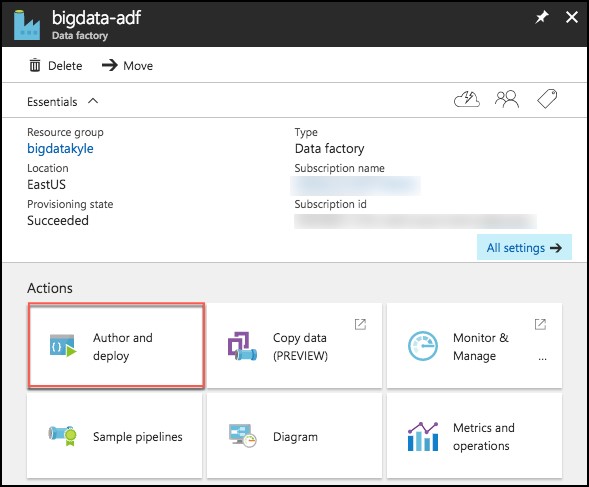
-
On the Author and Deploy blade, select …More, the select New Compute.
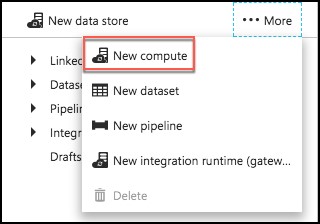
-
Select Azure ML from the New Compute list.

-
In the new window, replace the contents of the file with the following JSON.
- Back in Exercise 1, Task 9, you left your ML Web Service’s Consume page open. Return to that page, and copy and paste the following values into the JSON below.
- The value of mlEndpoint below is your web service’s Batch Request URL, remember to **remove the query string (e.g., “?api_version=2.0”).
- apiKey is the Primary Key of your web service.
- Your tenant string should be populated automatically.
- Delete the other optional settings (updateResourceEndpoint, servicePrincipalId, servicePrincipalKey).
{ "name": "AzureMLLinkedService", "properties": { "type": "AzureML", "description": "", "typeProperties": { "mlEndpoint": "<Specify the batch scoring URL>", "apiKey": "<Specify the published workspace model’s API key>", "tenant": "<Specify your tenant string>" } } }
-
Select Deploy.

Task 2: Create Azure ML input dataset
-
Still on the Author and Deploy blade, select …More again.
-
To create a new dataset that will be copied into Azure Blob storage, select New dataset from the top.

-
Select Azure Blob storage from the list of available datasets.
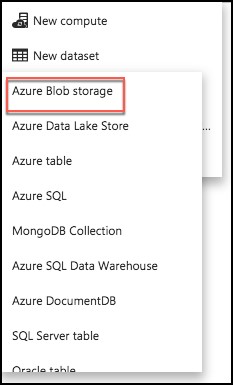
-
Replace the JSON text in the draft window with following JSON.
{
"name": "PartitionedBlobInput",
"properties": {
"published": false,
"type": "AzureBlob",
"linkedServiceName": "BlobStorageOutput",
"typeProperties": {
"fileName": "FlightsAndWeather.csv",
"folderPath": "sparkcontainer/FlightsAndWeather/{Year}/{Month}/",
"format": {
"type": "TextFormat"
},
"partitionedBy": [
{
"name": "Year",
"value": {
"type": "DateTime",
"date": "SliceStart",
"format": "yyyy"
}
},
{
"name": "Month",
"value": {
"type": "DateTime",
"date": "SliceStart",
"format": "MM"
}
}
]
},
"availability": {
"frequency": "Month",
"interval": 1
},
"external": true,
"policy": {}
}
}
-
Select Deploy.

Task 3: Create Azure ML scored dataset
-
Select …More again, and select New dataset.

-
Select Azure Blob storage from the list of available datasets.
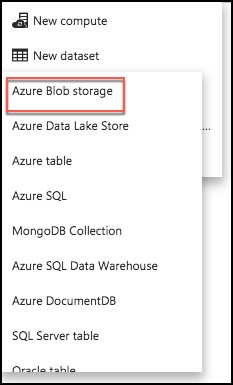
-
Replace the JSON text in the draft window with following JSON.
{
"name": "ScoredBlobOutput",
"properties": {
"published": false,
"type": "AzureBlob",
"linkedServiceName": "BlobStorageOutput",
"typeProperties": {
"fileName": "Scored_FlightsAndWeather{Year}{Month}.csv",
"folderPath": "sparkcontainer/ScoredFlightsAndWeather",
"format": {
"type": "TextFormat"
},
"partitionedBy": [
{
"name": "Year",
"value": {
"type": "DateTime",
"date": "SliceStart",
"format": "yyyy"
}
},
{
"name": "Month",
"value": {
"type": "DateTime",
"date": "SliceStart",
"format": "MM"
}
}
]
},
"availability": {
"frequency": "Month",
"interval": 1
}
}
}
-
Select Deploy.

Task 4: Create Azure ML predictive pipeline
-
Select …More again, and select New pipeline.
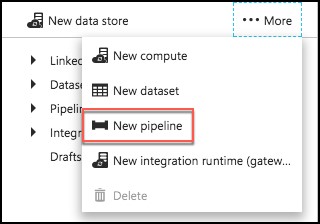
-
Replace the JSON text in the draft window with following JSON.
{
"name": "MLPredictivePipeline",
"properties": {
"description": "Use AzureML model",
"activities": [
{
"type": "AzureMLBatchExecution",
"typeProperties": {
"webServiceInput": "PartitionedBlobInput",
"webServiceOutputs": {
"output1": "ScoredBlobOutput"
},
"webServiceInputs": {},
"globalParameters": {}
},
"inputs": [
{
"name": "PartitionedBlobInput"
}
],
"outputs": [
{
"name": "ScoredBlobOutPut"
}
],
"policy": {
"timeout": "02:00:00",
"concurrency": 10,
"retry": 1
},
"scheduler": {
"frequency": "Month",
"interval": 1
},
"name": "MLActivity",
"description": "prediction analysis on batch input",
"linkedServiceName": "AzureMLLinkedService"
}
],
"start": "2017-03-01T00:00:00Z",
"end": "2099-12-31T11:59:59Z",
"isPaused": false,
"pipelineMode": "Scheduled"
}
}
-
Select Deploy.

Task 5: Monitor pipeline activities
-
Close the Author and Deploy blade, and return to the Data Factory overview.
-
Select Monitor & Manage under Actions.
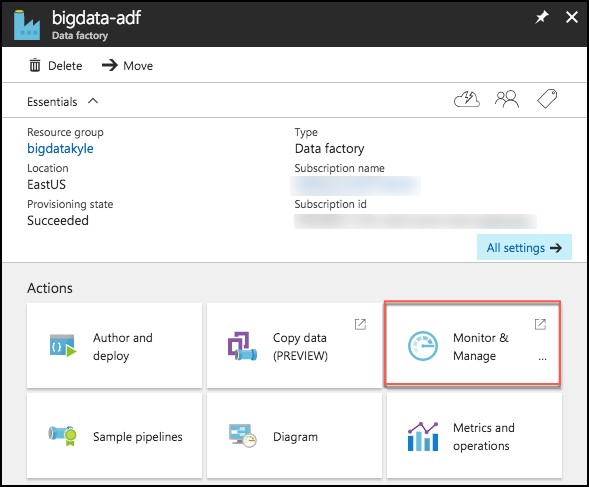
-
Once again, you may need to shift the start time in order to see the items in progress and ready states.

-
Close the Monitor & Manage browser tab.